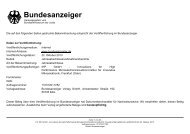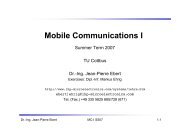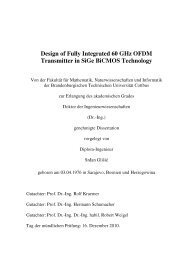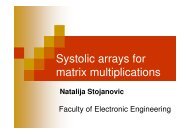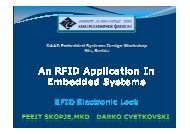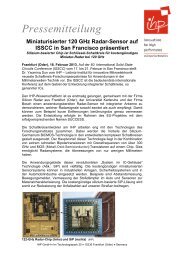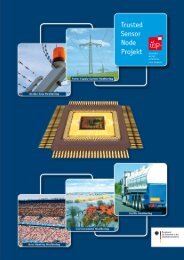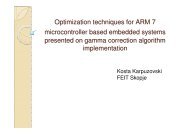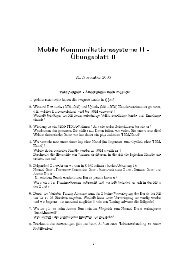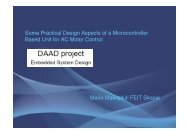Evaluating Virtex-II Pro Development System, it's features and ...
Evaluating Virtex-II Pro Development System, it's features and ...
Evaluating Virtex-II Pro Development System, it's features and ...
Create successful ePaper yourself
Turn your PDF publications into a flip-book with our unique Google optimized e-Paper software.
Vasko Mitanov<br />
Faculty of Electrical Engineering <strong>and</strong> Information Technologies,<br />
University Ss. Cyril <strong>and</strong> Methodius, Macedonia<br />
Email: vasko.mitanov@gmail.com
<strong>Pro</strong>vides an advanced hardware platform that<br />
consists of a high performance <strong>Virtex</strong>-<strong>II</strong> <strong>Pro</strong><br />
Platform FPGA<br />
Surrounded by a comprehensive collection of<br />
peripheral components that can be used to<br />
create a complex system <strong>and</strong> to<br />
demonstrate the capability of the <strong>Virtex</strong>-<strong>II</strong><br />
<strong>Pro</strong> Platform FPGA.
The core of development board is Xilinx <strong>Virtex</strong>-<strong>II</strong><br />
<strong>Pro</strong> XC2VP30<br />
<strong>Virtex</strong>®-<strong>II</strong> <strong>Pro</strong> FPGA with PowerPC® 405 cores<br />
Up to 2 GB of Double Data Rate (DDR) SDRAM<br />
<strong>System</strong> ACE controller <strong>and</strong> Type <strong>II</strong><br />
CompactFlash connector for FPGA configuration<br />
<strong>and</strong> data storage<br />
Embedded Platform Cable USB configuration port<br />
High-speed SelectMAP FPGA configuration from<br />
Platform Flash In-<strong>System</strong><br />
<strong>Pro</strong>grammable Configuration PROM<br />
Support for “Golden” <strong>and</strong> “User” FPGA<br />
configuration bitstreams
On-board 10/100 Ethernet PHY device<br />
Silicon Serial Number for unique board identification<br />
RS-232 DB9 serial port<br />
Two PS-2 serial ports<br />
Four LEDs connected to <strong>Virtex</strong>-<strong>II</strong> <strong>Pro</strong> I/O pins<br />
Four switches connected to <strong>Virtex</strong>-<strong>II</strong> <strong>Pro</strong> I/O pins<br />
Five push buttons connected to <strong>Virtex</strong>-<strong>II</strong> <strong>Pro</strong> I/O pins<br />
Six expansion connectors joined to 80 <strong>Virtex</strong>-<strong>II</strong> <strong>Pro</strong><br />
I/O pins with over-voltage protection<br />
High-speed expansion connector joined to 40 <strong>Virtex</strong>-<br />
<strong>II</strong> <strong>Pro</strong> I/O pins that can be used differentially or single<br />
ended
AC-97 audio CODEC with audio amplifier <strong>and</strong><br />
speaker/headphone output <strong>and</strong> line level output<br />
Microphone <strong>and</strong> line level audio input<br />
On-board XSGA output, up to 1200 x 1600 at 70 Hz<br />
refresh<br />
Three Serial ATA ports, two Host ports <strong>and</strong> one<br />
Target port<br />
Off-board expansion MGT link, with user-supplied<br />
clock<br />
100 MHz system clock, 75 MHz SATA clock<br />
<strong>Pro</strong>vision for user-supplied clock<br />
On-board power supplies<br />
Power-on reset circuitry<br />
PowerPC 405 reset circuitry
5V Regulated Power Supply Interface. The board includes<br />
power supply subsystem for generating additional 3.3V,<br />
2.5V <strong>and</strong> 1.5V for various block of the FPGA (core,<br />
peripheral, I/O)<br />
The board includes 8 Multi-Gigabit Transceivers. Three<br />
pairs of MGT are terminated by SATA connectors located<br />
on the board <strong>and</strong> one pair is terminated by optional SMA<br />
connector. There is independent 75MHz clock for SATA<br />
communication via MGT transceivers. Two SATA ports are<br />
configured as Host ports, one port is configured as Target<br />
port.<br />
Another very important feature of the board is<br />
incorporated JEDEC 184 pin DDR (Double Data Rate)<br />
SDRAM port which supports up to 2 GB memory modules.
Fast Ethernet 10/100 IEEE compliant interface is implemented on<br />
the board. Only the PHY is implemented <strong>and</strong> the MAC layer is left<br />
to the developer to implement this layer <strong>and</strong> upper layers in<br />
FPGA. The Ethernet interface is implemented as st<strong>and</strong>ard RJ-45<br />
connector on the board.<br />
<br />
<br />
One Serial RS232 Port <strong>and</strong> two PS/2 ports are provided on the<br />
board. The RS-232 port is implemented as DB-9 connector on<br />
the board. The board provides electronic circuits to provide<br />
necessary voltage levels for RS-232 st<strong>and</strong>ard.<br />
The board provides XSGA interface via DAC with 180 MHz clock.<br />
This DAC can provide VESA compatible output of 1280x1024<br />
pixels at refresh rate of 75 Hz or maximal 1600x1200 pixels at<br />
70 Hz refresh rate. Also 15 pin D-SUB connector is supplied on<br />
the board for connecting to monitor.
AC97 Audio codec with full-duplex stereo ADC <strong>and</strong> DAC<br />
are implemented on the board. This CODEC provides<br />
analog mixing <strong>and</strong> combining capabilities of microphone<br />
input, line-in input <strong>and</strong> PCM data. Output is stereo power<br />
amplified. There are st<strong>and</strong>ard audio input/output<br />
connectors located on the board.<br />
For various display <strong>and</strong> information purposes, the board<br />
includes four LED diodes which can be controlled by FPGA,<br />
four DIP Switches <strong>and</strong> five push buttons. All of these LEDs,<br />
switches <strong>and</strong> push buttons are controlled/monitored by<br />
FPGA directly. Specific pins on which this buttons <strong>and</strong> LEDs<br />
are connected can be found in UCFs (User Constraint<br />
Files), provided with additional CDs in the package along<br />
with this board.
The board is programmed via USB 2.0 interface. This<br />
interface configures <strong>and</strong> programs FPGA via<br />
Boundary-Scan.<br />
The board includes <strong>System</strong> Advanced Configuration<br />
Environment controller. This controller provides FPGA<br />
with configuration from various sources. This<br />
controller support: Compact Flash Port, JTAG Port,<br />
Microprocessor port <strong>and</strong> Test JTAG Port.<br />
Each board includes unique silicon serial number<br />
(SSN) which can be read by FPGA <strong>and</strong> can be used in<br />
designs where unique identification of the board is<br />
required.
<strong>Virtex</strong>-<strong>II</strong> <strong>Pro</strong> <strong>Development</strong> <strong>System</strong> does not<br />
come with any development or design tools<br />
for HDL, synthesis, design implementation or<br />
configuration of FPGA XC2VP30.
EDA tools from Xilinx that support this<br />
development system:<br />
- ISE Design Suite<br />
- Embedded Developers Kit (EDK) <strong>and</strong><br />
- ChipScope <strong>Pro</strong>.
ISE Design Suite from Xilinx is complete design environment for<br />
developing FPGA in all phases:<br />
<br />
<br />
<br />
<br />
<br />
Design entry. <strong>Pro</strong>cess of describing design of the system in one<br />
of the following ways: by HDL, VHDL, Verilog, <strong>System</strong>-C or<br />
schematic.<br />
Synthesis. <strong>Pro</strong>cess of generating netlist files from designs of<br />
previous phase.<br />
Implementation. Converting logical design into device dependant<br />
format.<br />
Verification. <strong>Pro</strong>cess of verifying functionality of design.<br />
Verification can be made by simulator or with ChipScope <strong>Pro</strong> by<br />
in-circuit verification process after device programming.<br />
Device Configuration. The process of download configuration<br />
files to development board.
Important notes regarding ISE:<br />
Last supported version of ISE supported by<br />
<strong>Virtex</strong>-<strong>II</strong> <strong>Pro</strong> <strong>Development</strong> <strong>System</strong> is ISE v10.1<br />
Newer versions of ISE(11.x+) are not<br />
supported.<br />
Older versions of ISE (7.0 - 9.2) don’t fully<br />
support <strong>Virtex</strong>-<strong>II</strong> <strong>Pro</strong> board.<br />
ISE WebPACK edition (the only free edition<br />
of ISE) is not supported by <strong>Virtex</strong>-<strong>II</strong> <strong>Pro</strong><br />
<strong>Development</strong> <strong>System</strong>.
EDK is integrated development environment for<br />
designing embedded processing systems.<br />
Supported embedded processor cores:<br />
- PowerPC® 405 hard processor cores<br />
- MicroBlaze soft processor cores
ChipScope <strong>Pro</strong> is tool for analyzing internal<br />
FPGA signals including embedded processor<br />
busses.<br />
Signals are captured at or near operating<br />
speed.<br />
Extensive support for embedded hard<br />
processor cores PowerPC 405® <strong>and</strong><br />
MicroBlaze.
Tools <strong>and</strong> configuration files needed for setting up complete development<br />
environment:<br />
<br />
Xilinx ISE 10.1 (At least Foundation/Logic Edition). Can be bought from<br />
Xilinx website: http://www.xilinx.com/tools/designtools.htm<br />
Xilinx EDK. Can be bought separately or in bundle with Xilinx ISE 10.1<br />
Embedded or with <strong>System</strong> Edition.<br />
<br />
<br />
IP Cores for peripherals on <strong>Virtex</strong>-<strong>II</strong> <strong>Pro</strong> <strong>Development</strong> <strong>System</strong>. This IP<br />
Cores can be found on CD that comes with board (the files are located in<br />
directory \V2P_CD\lib on the CD). Note that these files cannot be found<br />
on the Internet.<br />
User Constraint Files (UCF) for this board. These files are describing pinout<br />
<strong>and</strong> I/O drive characteristics for peripherals on <strong>Virtex</strong>-<strong>II</strong> <strong>Pro</strong><br />
<strong>Development</strong> Board (AC97/Ethernet/XSGA/DDR/Serial/PS2 etc…). Latest<br />
version of these files can be downloaded from:<br />
http://www.xilinx.com/univ/XUPV2P/UCF_Files/UCF_FILES.zip
Install ISE <strong>and</strong> EDK.<br />
After installation of ISE <strong>and</strong> EDK, the installer automatically<br />
installs Windows drivers that support communication<br />
with <strong>Virtex</strong>-<strong>II</strong> <strong>Pro</strong> <strong>Development</strong> Board via USB.<br />
After installation of USB Windows drivers, development<br />
board can be connected to PC by supplied USB cable <strong>and</strong><br />
then can be powered ON.<br />
After Windows detects development board <strong>and</strong> configures<br />
appropriate drivers, the board needs to be configured with<br />
utility iMPACT located in:<br />
XILINX_INSTALL_DIR\10.1\ISE\bin\nt\impact.exe<br />
Unpack <strong>and</strong> copy IP Cores for peripherals (directory<br />
xup_v2pro_dev_brd) for example on c:\<br />
xup_v2pro_dev_brd. DO NOT USE directories with names<br />
containing spaces.<br />
Unpack <strong>and</strong> copy User Constraint Files into same location
Optionally, if we want to use sample reference<br />
designs supplied with CD that comes with <strong>Virtex</strong>-<br />
<strong>II</strong> <strong>Pro</strong> board, we need to download <strong>and</strong> install:<br />
◦ PLB IP Core for DDR memory version 1.11a<br />
(plb_ddr_v1_11_a<br />
plb_ddr_v1_11_a) from Xilinx support forums because<br />
PLB IP Core for DDR supplied with ISE v10.1 is version<br />
2.00.1b <strong>and</strong> is not backward compatible with version<br />
1.11a.<br />
For new designs IP core mpmc (Multi-Port Memory<br />
Controller) should be used. Plb_ddr_v2_00 has obsolete<br />
PLB v3.4 support. Xilinx migrated newest IP Cores to PLB<br />
v4.6. (mpmc supports PLB v4.6)
Updated version of xup_v2pro_dev_brd that<br />
supports Xilinx ISE 10.1 <strong>and</strong> EDK can be<br />
found on Univeristy of Kansas website:<br />
https://wiki.ittc.ku.edu/ittc/images/6/64/Xu<br />
p_xbd.zip<br />
This version additionally adds support for Multi<br />
Port Memory Controller (mpmc IP).
◦ <strong>Pro</strong>blem with supplied reference designs using soft<br />
IP Core xilnet v1.00a (xilnet_v1_00_a) for TCP/IP<br />
stack because this IP Core is no longer supported<br />
<strong>and</strong> distributed by Xilinx. Recommended<br />
replacement for xilnet v1.00a by Xilinx is lwip IP<br />
Core v1.00/v2.00/v3.00. Because lwip IP Core is<br />
larger than xilnet (it requires OS supporting<br />
functions), lwip can be used in RAW mode which<br />
doesn’t require OS support. Lwip IP core is not API<br />
compatible with Xilnet.
Purpose of this sample project:<br />
To demonstrate some of the capabilities of<br />
<strong>Virtex</strong>-<strong>II</strong> <strong>Pro</strong> <strong>Development</strong> <strong>System</strong> <strong>and</strong> to get<br />
acquainted with development environment.
Following <strong>features</strong> were chosen to be evaluated:<br />
<br />
<br />
<br />
<br />
<br />
<br />
<br />
<br />
Creation, Synthesis, Verification <strong>and</strong> Deployment of sample project in Xilinx EDK;<br />
Embedded hardware processor cores Power PC® 405 located in XC2VP30 FPGA;<br />
IP core wrapper for embedded hardware processor core (PPC405);<br />
IP core for Serial Communication (RS-232);<br />
IP core that controls/drives Dual Rank 512MB DDR memory;<br />
Connecting DDR IP core with Embedded <strong>Pro</strong>cessor IP Core via PLB bus;<br />
Mounting external 512MB DDR Memory module on JEDEC 184 pin port to evaluate<br />
board conformity (mechanical <strong>and</strong> electrical) to JEDEC DDR-SDR st<strong>and</strong>ard<br />
specifications;<br />
Developing example application in application programming language C that runs<br />
on one of the Power PC 405 processor cores <strong>and</strong> uses all of above mentioned<br />
<strong>features</strong> (IP cores, Embedded <strong>Pro</strong>cessor, RS232 <strong>and</strong> DDR Interfaces) by testing<br />
DDR 512MB memory <strong>and</strong> sends results to PC via RS-232 interface.
Results:<br />
Software application running on one PowerPC core successfully<br />
used all of the supplied 512MB external RAM memory <strong>and</strong><br />
results were successfully sent to host PC.<br />
When the DDR memory module was removed* from the 184 pin<br />
port, the software application running on PC successfully<br />
detected absence of memory module.<br />
Note that EDK project should be saved in directory that doesn’t<br />
contain spaces (full path to the file). Because gcc compiler <strong>and</strong> ld<br />
linker will fail.<br />
*Memory Module was removed from the board while power was switched<br />
off
Xilinx-<strong>II</strong> <strong>Pro</strong> development system has a lot of<br />
peripherals integrated on the board which<br />
can be used by supplied IP Cores<br />
By proper installation <strong>and</strong> setup of software<br />
<strong>and</strong> hardware environment, Xilinx-<strong>II</strong> <strong>Pro</strong><br />
development system becomes very powerful<br />
FPGA research platform for commercial<br />
purposes as well for engineering curricula
Thank You!



